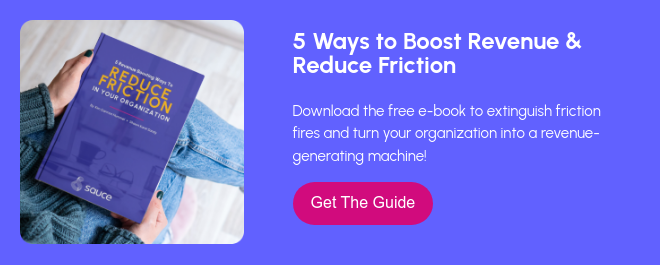Why Is Customer Delight So Important?
It costs nearly seven times more money to attract and convert new customers than it does to delight existing customers. That’s it, that’s the blog. Now you know why customer delight is so important. Thank you for coming!
All joking aside, delighting your customers saves you money. It saves you time. And plus, it keeps your customers coming back. Let’s dig into customer delight, how you can do it, and why working with Sauce is a smart way to delight your customers and #GrowSmarter.
What does delighting the customer mean?
You’ve put in the work to attract visitors. Your business reached and converted best-fit customers that know your services and products are the solution to their problem.
Now it’s your job to keep them coming back for more by exceeding their initial expectations. That’s customer delight. It’s less about whether your product and services are the best in the business (though it’s important not to make promises you can’t keep). It’s more about delivering a personalized, meaningful experience along with your services and products. That’s the secret sauce! It establishes an emotional connection that says your business cares.
How can you delight your customers?
None of this is easy. I want to say that upfront. Customer delight is a strategic, long-term process that will pay off in spades. That’s something you need to keep in mind. It’s not a quick sale and not just about making a customer happy once. It’s about building and maintaining a trusting relationship that produces as much value for your customer as possible.
Reduce friction
Friction is the distance between where your customer is and where you want them to be, and often results in lost opportunities. Friction can lead to expensive churn. Discovering friction is tricky, but it could be the difference between a successful ongoing relationship and a lost opportunity.
Don’t confuse poor service with friction. It’s easy to conflate the two into one pot. While customer service is about execution, reducing friction is about planning ahead. Did customers take the predetermined path that you built (i.e. did they travel down your sales funnel as you intended)? Did they understand your messaging and take the desired action that you wanted them to take? These are just some of the questions you need to reflect and build upon as you optimize your customer’s journey. One of the best things you can do for a repeat customer is to make buying or working with you even easier the second time around. That’s what reducing friction is all about.
Two great tools to identify friction in your customer’s journey are heat mapping and cookies. A heat map is a visual representation of exactly where customers go and what they do on your website. It’s website cartography. Say for example you changed the color of a bit of text on one of your web pages. You intended that color change to emphasize the text—you wanted that message to really stand out. In reality, however, your heat map may reveal that multiple people tried to click on that text, thinking it was a link. Heat mapping gives you the opportunity to see how your website visitors interact with your website. You can quickly identify and correct friction in your customer’s experience!
A cookie is a piece of code that tracks a visitor’s digital body language. How did they get to your website? And where do they go once they leave? It’s the simplest, primary tool that makes advertising technology and tracking so powerful. When used responsibly, cookies can provide immense value to your customers by helping you understand their wants and needs as they return to your website. You may have read that Google and Apple are affecting how cookies work—click here to read our blog all about it.
Understand your persona’s core problem
Customers expect you to understand their core problem. That’s the biggest pain point or challenge they’re experiencing right now. If you don’t relate and offer a solution to their problem, they’ll move on to a business that does. This is by far the most important step as you begin developing a system to delight your customers. If you fail to attract them at all, you’ll have no customers to delight.
Understand your customer’s problem. Get your strategy right. Be a guide down the path you want your customers to take.
A great tool to develop a strategy around your persona’s core problem is StoryBrand, a popular messaging framework that helps your business say what your customers need to hear about your business.
Develop a shared knowledge base
This is a fancy way of saying a customer relationship management tool, or CRM, is the smartest choice for your business. You want to delight your customers. That’s why you’re here! A CRM sets you up for success. The powerful HubSpot CRM boasts a ton of great tools, even without a paid subscription. The contacts tool in HubSpot offers clear visibility and plenty of storage to keep conversations and data in one place—centered around the contact. So no matter what, your business knows who this customer is and the history that customer has with your business. It’s incredibly easy and helpful to use.
Work with Sauce Agency to build a community of loyal customers!
I said it at the start of this blog: It costs nearly seven times more money to attract and convert new customers than it does to delight existing customers. Don’t waste money guessing about what might work. Instead, work with us. Sauce Agency is a HubSpot Certified Solutions Partner and a Certified StoryBrand Agency. It means we know what tools work best to help you reach your goals, and how to use them to delight your customers. And when you delight your customers, you generate more revenue to keep growing!
Contact one of our Growth Guides today! You’ll be delighted that you did.
.webp?width=12693&height=4513&name=Sauce%20Logo%20Dark%20Ht%20(1).webp)

.webp?width=180&height=64&name=Sauce%20Logo%20Dark%20Ht%20(1).webp)











